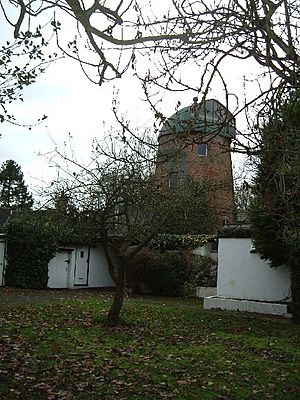Goldfield Mill, Tring facts for kids
Quick facts for kids Tring Windmill |
|
|---|---|

Goldfield Mill, Tring from Icknield Way
|
|
| Origin | |
| Mill name | Goldfield Mill Grover's Mill |
| Mill location | SP 915 117 |
| Coordinates | 51°47′49″N 0°40′30″W / 51.79694°N 0.67500°W |
| Operator(s) | Private |
| Year built | c1839 |
| Information | |
| Purpose | Corn mill |
| Type | Tower mill |
| Storeys | Four storeys |
| No. of sails | Four sails |
| Type of sails | Double Patent sails |
| Winding | Fantail |
| Auxiliary power | Steam engine |
Goldfield Mill, also known as Grover's Mill, is a historic tower mill found in Tring, Hertfordshire, England. This old mill is a Grade II listed site, which means it's an important building protected for its history. Today, it has been changed into a home.
A Look Back: The History of Goldfield Mill
Goldfield Mill was first mentioned in an old record called Pigot's Directory in 1839. At that time, James Grover was the miller, the person who operated the mill. The mill stayed in the Grover family until 1880.
Later, in 1898, a 6 horsepower (4.5 kW) steam engine was added. This engine provided extra power to help the mill work, especially when there wasn't enough wind. The mill continued to grind grain using wind power until 1908.
After 1908, the mill kept working with its steam engine until the 1920s. In 1973, Goldfield Mill was transformed from a working mill into a place where people could live.
What Does Goldfield Mill Look Like?
Goldfield Mill is a tower mill, which means it's a type of windmill built like a tall, round tower. It has four storeys, or levels, inside.
The top of the mill had a special roof called a "pepperpot cap." This cap could turn to face the wind, helped by a "fantail." A fantail is a small windmill at the back of the cap that automatically turns the main sails into the wind.
The mill also had four "Double Patent sails." These were the large arms with canvas that caught the wind to make the mill work. Inside, some original parts still remain, like the "upright shaft" and a cast iron "great spur wheel." These parts were important for transferring power from the sails to the grinding stones.
Who Ran the Mill? Millers Through Time
Many different millers operated Goldfield Mill over the years. Here are some of the people who ran the mill:
- James Grover (1839-1861)
- William Grover (1861-1880)
- Thomas Liddington (1880-1885)
- White & Putnam (1885-1895)
- James Wright (1895-1908)

